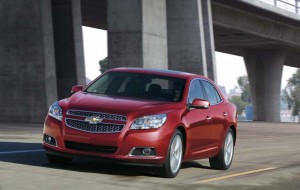Chevrolet’s goal of regaining its once-lofty position in the U.S. midsize sedan market have failed to materialize –forcing the maker to slash prices and order up an “emergency refresh” of the only recently redesigned Malibu.
General Motor’s largest brand will slash the price on its midsize Malibu by as much as $770 hoping to keep the sedan from losing more ground to its import and domestic competitors. Introduced in early 2012, the domestic 4-door faces a formidable assortment of competitors in one of the market’s toughest segments, including all-new versions of the Ford Fusion, Nissan Altima and Honda Accord, as well as the midsize sales leader, the Toyota Camry.
Malibu sales did post a modest gain in 2012, according to tracking firm Autodata, but the 3.3% rise, to 210,951 units, lagged well behind the overall 13.5% increase in the U.S. market. Malibu’s unanticipated shortfall is one reason why parent General Motors lost 1.5 points of market share in 2012, industry analysts report.
On January 1, Chevy dealers had a 129-day supply of Malibus on their lots – twice the industry norm. That fell to 94 days a month later though that is still well above the 60-day inventory manufacturers normally target.
Chevrolet officials say they believe the price cut should “bring additional potential buyers” into their showrooms for the Malibu which went through an unusual, two-stage launch process. The high-mileage Malibu Eco was introduced at the beginning of 2012, with more conventional versions such as the 2LT, LTZ and LT launching a half-year later.
Some observers believe the staggered roll-out may have compounded the problems the Malibu has faced, but the vehicle has also faced some sharp criticism from reviewers, notably for its bland styling and relatively cramped interior – the rear seat of the 2013 model actually losing about an inch of legroom compared to the model it replaced. On the other hand, the midsize sedan has also won praise for its well-appointed cabin and for innovative details such as the hidden storage bin tucked behind the fold-up infotainment screen.
Prices will be cut by anywhere from $300 for the 2013 Chevrolet Malibu Eco and 2LT models, to as much as $770 on the Chevy Malibu LT. Including destination charges, that latter base model will now come in at just $22,805 – still $335 more than the cheapest Honda Accord, but $225 under the base Toyota Camry, the segment leader.
Chevy – and GM – desperately need to turn things around for Malibu. The Chevrolet brand is targeting a 7% sales increase this year while General Motors Chairman and CEO Dan Akerson has said he hopes to achieve a modest share increase after watching GM dip to a weak 16.9% of the U.S. market last year.
The maker did see some momentum build in January but clearly needs its main midsize model lead the charge.
Exactly what the maker might accomplish with a quick update of the Malibu – rather than waiting for the normal, mid-cycle changes that would likely not come for several more years – is uncertain. The emergency refresh will reportedly aim to address the complaints about lackluster exterior styling.
But there’s only so much that can be done with concerns about interior roominess. The maker might try new seats, perhaps carving out knee space in the back side of the front buckets. More significant changes would likely have to wait for the full Malibu makeover late in the decade.
Chevy isn’t the only maker of late to race out an update to address sharp criticism. Honda recently unveiled a revised version of the Civic sedan it launched for 2012 to unusually harsh reviews.


It’s odd that this generation Malibu is having sales issues as it’s a pretty nice vehicle by all accounts. I don’t think the imports or other domestic competition has a styling or performance advantage per se. Perhaps there are just too many models to chose from with every car maker offering niche models now?
The 2008-2012 Malibu was an impressive update. But add Camaro like dash and tail designs, remove the V6 option (remember the intended audience), and tighten the rear seating a little- and what you have is a 2013 that appears to be designed by committee, without much overall appeal. This is essentially a Hyundai Sonata lineup trying to look a little more “butch.”
What’s disappointing is that there are, in fact, a number of solid improvements in the latest Malibu, such as the overall dash design with that hidden storage compartment behind the infotainment display, and the overall noise level and quality. But, yes, they clearly missed on other key attributes that could’ve made this car a real midsize segment contender.
Paul A. Eisenstein
Publisher, TheDetroitBureau.com